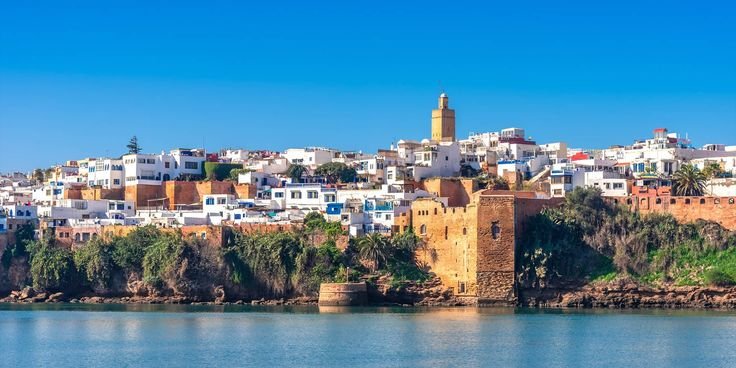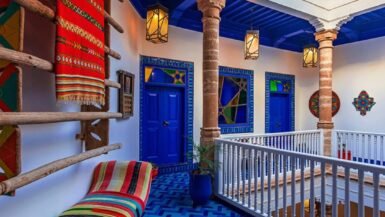Perched like a jewel at the mouth of the Bou Regreg River in Rabat, the Kasbah of the Udayas captivates visitors with its ancient ramparts and enchanting alleyways that reflect a rich history and deep culture. This unique historical monument, which is part of Rabat’s UNESCO World Heritage site, blends past and present in a captivating way. In this comprehensive guide, we’ll take you on a journey to discover the multiple historical layers of the Kasbah of the Udayas, its unique architectural beauty, the main attractions within its walls, and practical information for visitors.
Table of Contents
History of the Kasbah of the Udayas: Centuries of Transformation
The Kasbah of the Udayas has undergone numerous historical transformations, evolving from a small military ribat to a grand Almohad fortress, then becoming home to the Udayas tribe, making it a living witness to the vicissitudes of Moroccan history.
The First Ribat and Its Strategic Position
The story of the Kasbah of the Udayas begins in the 12th century as a small ribat (military outpost) established on a hill overlooking the mouth of the Bou Regreg River. This strategic position gave it great importance for monitoring ships entering and leaving the river, and for protecting the region against potential maritime invasions.
The Construction of the Almohad Fortress and Its Monumental Gate
The Almohad period (1121-1269) saw a major expansion of the Kasbah, particularly under the reign of Caliph Yaqub al-Mansur who transformed it into an imposing fortress to serve as a base for his military campaigns toward Andalusia. During this period, the massive walls and the impressive gate known as “Bab Oudaya” were built, an architectural masterpiece reflecting the splendor of Almohad art with its decorated arches and sophisticated geometric patterns.
The Settlement of the Udayas Tribe
In the 17th century, the Kasbah became home to the Udayas tribe, a military tribe that Sultan Moulay Ismail had brought from the Oued Draa region in southern Morocco. The Sultan offered them the fortress as a reward for their military services, and since then, it has been known as the “Kasbah of the Udayas” in their honor.
Over time, the Kasbah transformed from a purely military site into an inhabited residential area, while maintaining its defensive character and historic walls, thus becoming a living witness to the city’s history.
Architecture and Charm of the Kasbah of the Udayas: The Blue and White Alleyways
What distinguishes the Kasbah of the Udayas is its unique architectural style and peaceful atmosphere reminiscent of Andalusian alleyways, particularly with its distinctive blue and white colors that reflect a blend of Moroccan and Andalusian influences.
The Walls of the Kasbah of the Udayas
The Kasbah is surrounded by towering walls reaching over 10 meters in height in some places, built from solid sandstone during the Almohad era. These walls were intelligently designed to provide maximum protection to the fortress, with watchtowers at its strategic corners allowing a wide view of the surrounding areas, particularly toward the sea and the river mouth.
The Historic Gate of the Udayas
Bab Oudaya represents the most remarkable architectural masterpiece of the Kasbah, a massive Almohad gate built in the 12th century. It is distinguished by its imposing height and complex geometric decorations carved into stone. The gate consists of a large horseshoe arch surrounded by a square frame adorned with elaborate geometric patterns and inscriptions. The details of the gate reflect the talent of Almohad architects and their concern for combining defensive power with artistic beauty.
The Enchanting Alleyways and Blue and White Houses of the Udayas
As soon as you cross Bab Oudaya, you’re transported into a world of narrow, winding alleyways lined with pretty traditional houses. What characterizes these houses is their blue and white painting – with the base painted sky blue and the upper part bright white. This architectural tradition has its origins in Andalusian influences and has become one of the most striking aesthetic features of the Kasbah.
These alleyways are distinguished by their tranquility and authentic residential atmosphere, where relaxed cats roam and colorful flower pots adorn the thresholds of houses, giving a special charm to the place and making it an ideal destination for photography.
Main Attractions Inside the Kasbah of the Udayas
Inside the walls of the Kasbah of the Udayas, there are several places not to be missed, offering a mix of history, nature, and relaxation in an enchanting atmosphere.
The Andalusian Garden
This beautiful garden is located just after the main gate of the Kasbah and is an oasis of beauty and tranquility. Designed in the Andalusian style with a symmetrical geometric layout, it includes beautiful fountains and pathways shaded by palm trees, orange trees, and jasmine. The garden offers a refreshing refuge from the heat of the sun, where visitors can sit on benches scattered among colorful flowers and aromatic plants, and listen to the murmur of water flowing from the fountains.
The Moorish Café
The Moorish Café is one of the most famous cafés in Rabat, situated on a terrace offering views of the Bou Regreg mouth and the Atlantic Ocean. The café is distinguished by its authentic traditional Moroccan decor, with warm colors, wood carvings and ornaments, and comfortable traditional furniture. It serves traditional Moroccan mint tea and delicious Moroccan pastries such as “ghriba,” “makrout,” and “chebakia.” Sitting in this café enjoying tea while taking in the magnificent view of the sea and river is an unforgettable experience for visitors.
The Udayas Museum (Museum of Arts and Traditions)
The Udayas Museum is located in the heart of the Kasbah and is also known as the Museum of Arts and Traditions of Rabat. It occupies a riad (traditional Moroccan house) from the 17th century. The museum presents a superb collection of traditional Moroccan crafts, including ancient jewelry, ceramics, textiles, decorative objects, and traditional furniture. The building itself is an architectural masterpiece with an open central courtyard, stucco decorations, and colorful zellige mosaics.
Opening hours: Tuesday to Sunday, 9:00 AM to 5:00 PM. Entrance fee: approximately 10 Moroccan dirhams.
The Viewpoint
At the highest point of the Kasbah is a viewpoint offering spectacular panoramic views of the Bou Regreg mouth, the neighboring city of Salé, and the Atlantic Ocean. From here, visitors can observe traditional fishing boats entering and leaving the river, and admire the magnificent sunset over the ocean. This viewpoint is the ideal place to take stunning souvenir photos.
Cultural and Historical Significance of the Kasbah of the Udayas
The Kasbah of the Udayas represents exceptional importance both culturally and historically, as it is:
- A living witness to several historical periods, from its function as a small ribat to that of an Almohad fortress, then a settlement for the Udayas tribe.
- A remarkable example of Almohad military architecture, particularly in its imposing ramparts and majestic Bab Oudaya.
- A charming example of Moroccan-Andalusian residential architecture, visible in its blue and white alleyways.
- An essential element of Rabat’s UNESCO World Heritage site.
- A piece of living history, still inhabited by residents who maintain its traditional character.
Visiting the Kasbah of the Udayas: Practical Guide
To make your visit to the Kasbah of the Udayas a pleasant and smooth experience, here are some important tips that will help you enjoy everything this historical gem has to offer.
The Kasbah of the Udayas is located at the northern end of Rabat’s old city (the medina), near the mouth of the Bou Regreg River which separates the cities of Rabat and Salé.
How to Access the Kasbah of the Udayas
The main entrance to the Kasbah is through the historic Bab Oudaya gate. The Kasbah is easily accessible on foot from Rabat’s old medina or from the riverfront promenade. If you are in another part of Rabat, you can take a small taxi (“petit taxi”) and ask the driver to take you to “the Kasbah of the Udayas” or “Bab Oudaya.”
The Kasbah itself is a residential area open 24 hours a day, while the Andalusian Garden is open from 8:00 AM to 6:00 PM in summer, and from 9:00 AM to 5:00 PM in winter. The museum is open Tuesday to Sunday from 9:00 AM to 5:00 PM.
The main activities you can do during your visit include: walking through the charming blue and white alleyways, visiting the Andalusian Garden, enjoying tea at the Moorish Café, exploring the Udayas Museum, and enjoying panoramic views from the viewpoint.
A typical visit to the Kasbah takes between an hour and a half to two hours to comfortably explore the main sites.
Always remember that the Kasbah is a real residential area, so please respect the privacy of residents, maintain calm, and ask permission before photographing people. You can also visit the nearby Bou Regreg riverfront and Rabat beach which is located a short distance from the Kasbah.
Conclusion: The Kasbah of the Udayas, Rabat’s Historical Gem
The Kasbah of the Udayas represents a true gem in Rabat’s crown, with its historical depth, captivating beauty, and peaceful atmosphere. In today’s world, full of noise and hustle, the Kasbah offers a unique experience that takes visitors on a journey through time, where they can appreciate historical architecture and relax in an enchanting environment.
If you are planning to visit Rabat, the Kasbah of the Udayas should be at the top of your list of places to visit. It’s a completely different experience from the rest of the city’s attractions and will leave you with unforgettable memories.
We invite you to share your experiences and photos of the Kasbah of the Udayas in the comments below, or to share this article with friends interested in exploring Morocco’s historical and cultural treasures.
Other Sites Near the Kasbah of the Udayas
Near the Kasbah of the Udayas, you can visit the Souk Atiq (old city – the Kasbah) and Souk Bab Lahad, Souk Maaref and the small Souk Oudayas. You can also explore the Old Medina Souk (old Rabat) and head to Mohammed V Mausoleum and Bab Rouah.
Useful External Sources and Resources
For additional information about tourism in Morocco and planning your trip, we recommend consulting the following sources:
- Moroccan National Tourism Office – Official Morocco tourism website
- UNESCO World Heritage Site – Detailed information about Rabat’s World Heritage sites
- Morocco Ministry of Culture – Information about museums and cultural sites
- Official City of Rabat – Official website of Rabat city
- Lonely Planet Morocco Travel Guide – Travel tips and practical information
Written by: Ahmed El Mourabit – Expert in Moroccan tourism and author specializing in the history and culture of Rabat and Morocco’s historic cities.






Leave a reply